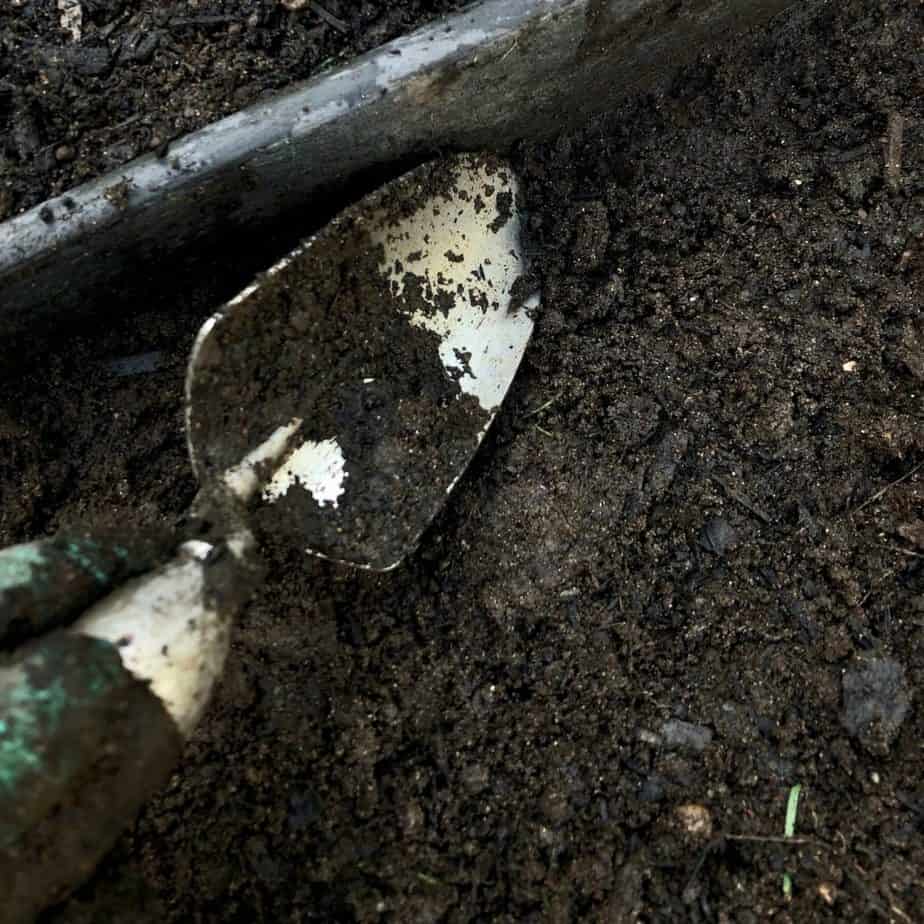
How to Compost: The Ultimate Guide to Composting
Learning how to compost will teach you how to speed up the natural decomposition of biological materials. Composting is SO helpful in diverting food and yard waste from the landfill. It also happens to make a wonderful soil amendment for your garden!
Here are the basic steps for easy composting at home:
- Collect compostable material like food scraps and yard waste.
- Cut or shred large pieces into smaller pieces.
- Mix everything together in a compost heap, bin, or tumbler.
- Add water and air on a regular basis.
Despite the steps being rather simple, there are quite a few questions that can arise during composting. Whenever doubts arise, its reassuring to remember that organic materials will all eventually turn into compost with or without your help! Read on to learn exactly how to compost effectively at home.
How to Compost: An Easy Step-by-Step Guide
Composting is the process of helping organic matter from your household to decompose. Starting to compost is a great way to decrease the amount of material you send to the local landfill. It also produces a nutrient-rich plant food for the garden!
Good compost is dark, crumbly, and has an earthy smell. Compost is just decomposed organic matter – its nothing fancy. Biological materials naturally degrade all on their own, but composting accelerates and controls the process. In any moment of composting self-doubt, remember that organic materials will rot without your help.
“It’s really hard to mess up compost so badly that you get no compost at all.”
Brett L. Markham, The MiniFarming Guide to Composting
There are a lot of different ways to make compost. Here is a step-by-step guide for how to compost using the most common method: aerobic outdoor composting.
Step 1: Collect Compostable Material Like Food Scraps and Yard Waste
Step 1 of the composting process is to collect compostable materials. Start with fruit and vegetable scraps from the kitchen. Yard waste is another great source of organic matter for the compost heap.
Good compost piles have a mixture of carbon-rich “brown” ingredients and nitrogen-rich “green” ingredients. Kitchen fruit and veggie scraps generally fall into the nitrogen-rich “green” category. Dried yard waste like autumn leaves, straw, and sawdust are considered carbon-rich “brown” materials.
Once the mixture is assembled, a host of microorganisms will work to decompose the material. You don’t have to add them…they’re already in the environment around you. Bacteria, fungi, and bigger critters digest the waste. The decomposition process also requires air, water, and time.
Step 2: Cut or Shred Large Pieces Into Smaller Pieces
Step 2 of composting is to cut or shred large pieces into smaller pieces. Smaller pieces decay more quickly. While even large wooden logs will eventually decompose, the purpose of home composting is to speed up the process so it takes weeks or months instead of years or decades!
Kitchen scraps are easy to cut up into small pieces if you’ve already got a cutting board out for food prep. Take a bit of time while you cook to chop up fruit and veggie scraps. They don’t have to be diced into tiny pieces, but a few chops will definitely speed things up in the compost.
Large autumn leaves compost best when they’re shredded prior to composting. Some gardeners will use a mulching lawnmower to shred a thin layer of leaves while cutting the grass. The mulched-up leaves and grass clippings make a well-balanced mix of compostables. Leaf vacuums can also be used to collect and shred up fallen leaves.
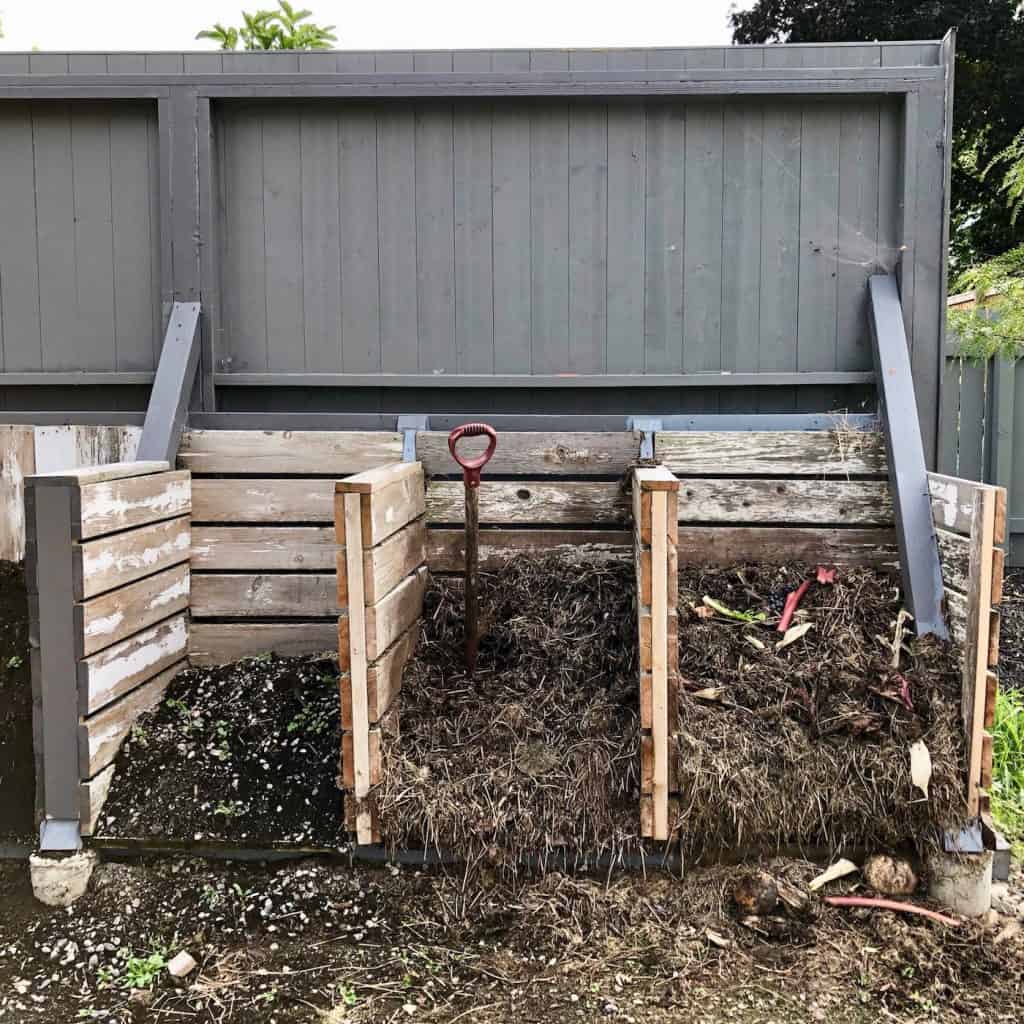
Step 3: Mix Everything Together in a Compost Heap, Bin, or Tumbler
Step 3 of how to compost is to mix everything together in a compost heap, bin, or tumbler. Try to make sure the different ingredients are well-mixed, almost as if you were baking something in the kitchen. Compost is like cooking a nutritious snack for your garden beds.
Compost piles and tumblers use an “aerobic composting process”. This means that oxygen is required to facilitate decomposition. Watering and turning the pile will help keep it at the moisture and oxygen levels that the beneficial microbes require to do their transformative work.
There are alternative methods of composting which do not require turning or adding extra water. These other options are perfect for those with apartments, those with freezing winters, and those who just don’t want to deal with a large outdoor compost pile. We’ll get to those methods later on in this article! They’re a little less common but just as useful.
Step 4: Add Water and Air to the Mixture Regularly
Step 4 of composting is to add water and air to the compost. Aerobic composting requires both air and water to support the microbes that decompose the organic matter.
Turn the compost pile every week or two. If using a tumbler, give it a spin whenever you add new food scraps. In dry times of the year, water the compost heap while you turn it. Compost tumblers can be watered with a garden hose or watering can.
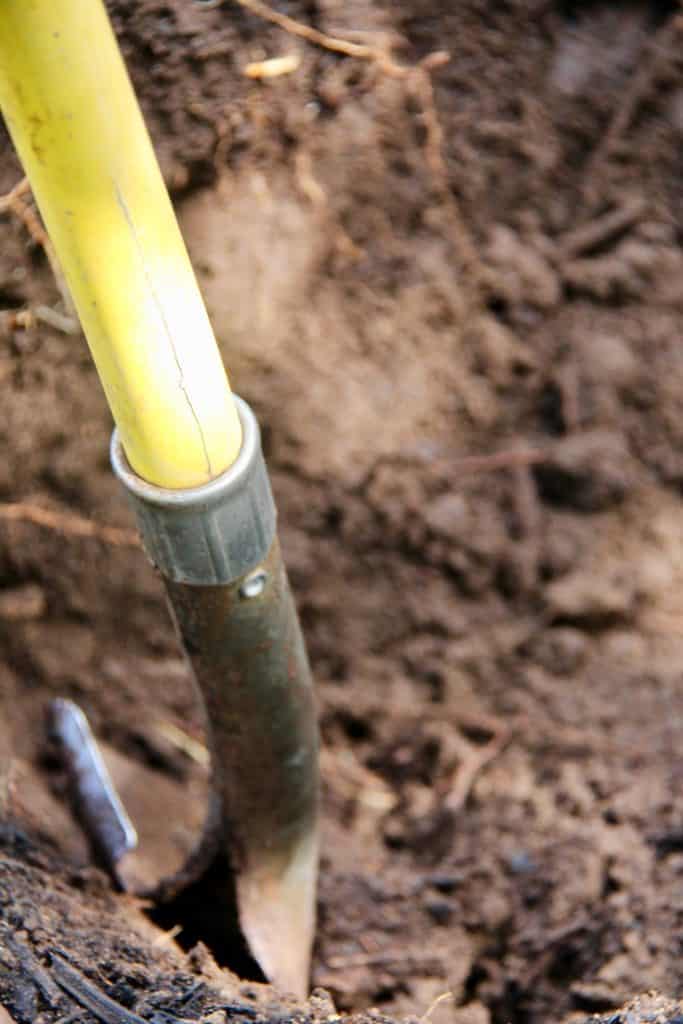
Why Is Composting Important? Reasons to Compost
There are two big reasons to compost: for the success of your own garden and for the overall health of the planet.
How Composting Helps the Environment
More composting means less organic waste going into the landfill. Organic matter is instead going back into productive soil. Waste also doesn’t have to be trucked from your home to the landfill, placed in a waste containment cell by a loader, and then compressed with a rolling compactor.
There are a lot of heavy diesel-powered trucks and machinery involved in the landfill process! It can seem easy just to throw organic waste out instead of composting it, but you’re really just passing on the task of dealing with it. Composting at home can be easy, it just takes a bit of thought on the subject!
“If we can continue making the recycling of organic wastes easier and more efficient, more and more people who didn’t previously compost will start composting.”
Adam Footer, Bokashi Composting
Compost Facts: Composting for the Environment
Here are some compost facts to encourage you to start composting!
- Food scraps and yard waste together currently make up about 30 percent of what we throw away, and should be composted instead. Making compost keeps these materials out of landfills where they take up space and release methane, a potent greenhouse gas. (Source: US Environmental Protection Agency)
- About 76% of food that could be composted ended up in landfills, as of 2015. (Source: US Environmental Protection Agency)
- In 2015, over 21 million tons of yard trimmings were composted – almost five times as much as in 1990. (Source: US Environmental Protection Agency)
- While composting efforts do produce greenhouse gas emissions, a study in California showed that the emissions reductions from commercial composting were several times higher than the emissions related to the composting process. (Source: California Environmental Protection Agency)
- A Danish study in 2010 showed that greenhouse gas emissions from home composting of organic household waste were in the same order of magnitude as for centralized composting plants. (Source: Technical University of Denmark)
- In 2011, over half of Canadian households (61%) had participated in some form of composting; this is up 38 percentage points from 1994. Forty-five percent of all households reported composting kitchen waste and 68% of households with a lawn or garden reported composting yard waste. (Source: Statistics Canada)
- San Francisco now composts all of the city’s yard waste and food scraps. Finished compost is sold as fertilizer to vineyards in wine country and nut growers in the Central Valley. (Source: CNBC)
- Compost application to agricultural soil reduces the amount of synthetic fertilizer needed, reduces the amount of water used, decreases soil erosion, increases soil carbon storage and reduces the use of herbicides. (Source: California Environmental Protection Agency)
It will be exciting to see these stats change over time as our composting systems improve in efficiency and usage.
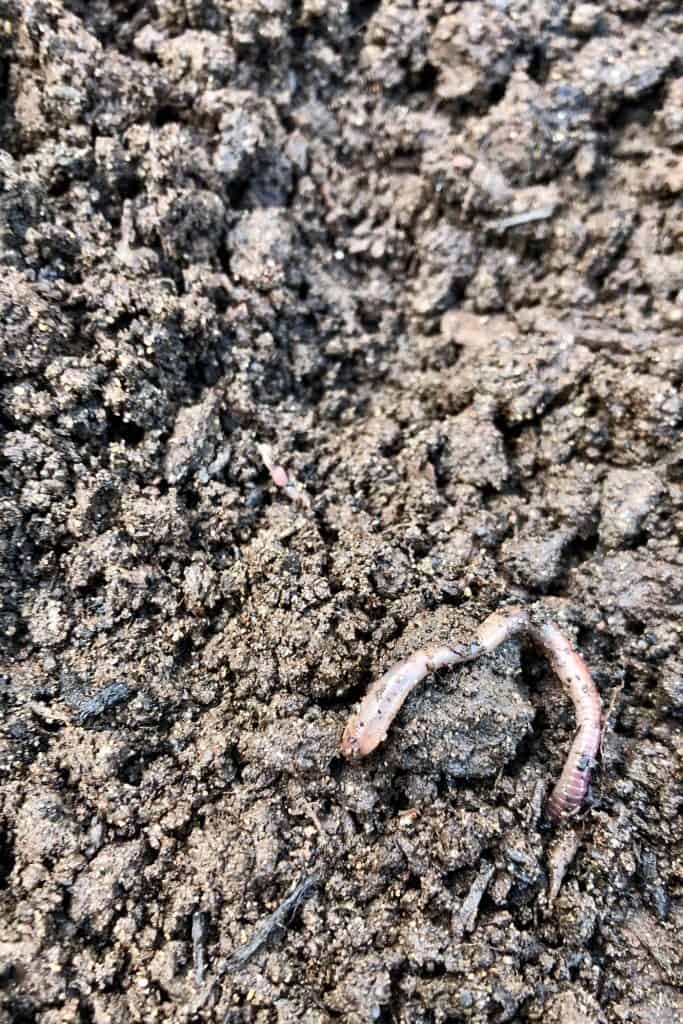
How Compost Helps Garden Soil & Plant
While composting is good for the environment, it’s REALLY good for your own garden. Homemade compost is perhaps the most important soil amendment in any healthy garden. There’s a reason it’s called “garden gold”!
When applied to the ground as a soil conditioner, compost adds nutrient-rich humus to the soil structure. This builds and helps sustain living soil. Adding compost also adds additional beneficial microorganisms to soil, in addition to supporting existing soil life.
“The math is straightforward: using compost means your garden will be more cost-effective because you will have to spend less money on fertilizers, insecticides, and fungicides for a given harvest of any crop. That means money. A lot of money.”
Brett L. Markham, The MiniFarming Guide to Composting
Compost improves garden soil and the plants that live in it. It improves the texture of heavy clay soil, yet can also add nutrient storage capacity to sandy soil. Improving your soil improves the health of plants, and compost is SUCH a great way to improve garden soil. Or so it is at Home for the Harvest 
Compost Facts: Composting for Your Garden
Some of the most inspiring facts about how great compost is for your garden come from the text “Science and Engineering of Composting: Design, Environmental, Microbiological and Utilization Aspects“. Here are a few memorable excerpts from the included paper “Enhancing soil fertility by addition of compost”, by Warren A Dick and Edward L. Mccoy (Ohio State University):
- At the end of the decomposition process associated with composting, the compost still carries an enormous population of microorganisms. Thus, application of composts adds not only organic matter containing material compounds, but also adds living organisms themselves. (Page 633)
- Increased soil organic matter concentrations are often associated with increased water retention over much of the range of soil matrix potentials. Correspondingly, compost addition to soil increases both the water holding capacity (Mays et al., 1973) and plant available water (Eliot Epstein et al. 1976). (Page 630)
- It is well known that organic matter can effectively bind pesticides, thus reducing their effective concentrations in soil. In several studies, compost additions removed the toxic effect of soil-applied pesticides. (Page 632)
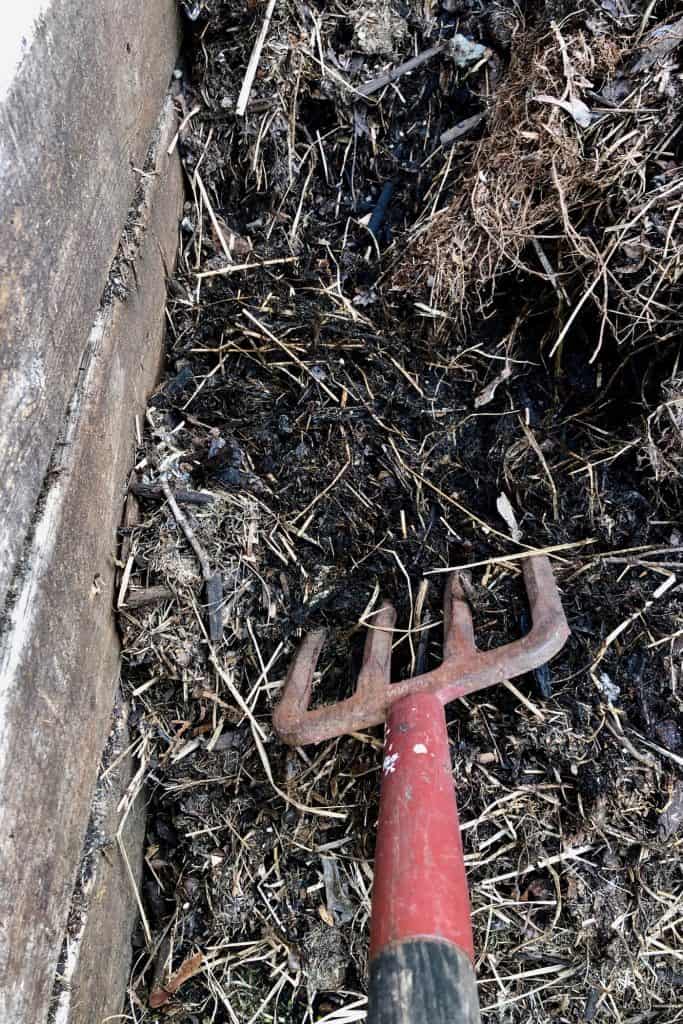
Composting 101: Compost Basics
So what is compost made of? Compost is made of decomposed organic matter. A good homemade compost is generally dark, crumbly, and smells slightly earthy.
Basic home composting requires five basic ingredients:
- Carbon-rich materials (“browns”), such as leaves, straw, bark, paper, corn stalks, wood chips or sawdust
- Nitrogen-rich materials (“greens”), such as grass clippings, vegetable scraps or coffee grounds
- Water
- Oxygen
- Microorganisms, such as bacteria, molds and fungi
Basic home compost should include all five of these ingredients for best results.
The Composting Process
So, how does composting work? The composting process is how humans help to speed up the decomposition of organic matter.
Composting works by providing a work crew of beneficial microbes with a happy home and then letting them do their own thing. Provide the microbes with food (organic waste), air, water, and warmth, and they will happily decompose your waste into lovely compost.
“There are various methods of composting, and the books and articles on the subject will generally give very specific instructions to follow. Actually, satisfactory results can be obtained without being so fussy.”
Harold Willis, Foundations of Natural Farming
I love the quote from Dr. Willis (above) and think of it often. Compost can work out perfectly well without delving deep into the science of decomposition. Remember this reassuring statement whenever you find yourself too far down the rabbit hole of composting science!
Types of Composting: Aerobic vs. Anaerobic Compost
Up to this point, we’ve covered basic home composting in a pile, bin or tumbler that is open to the air. As with anything, there is a lot out there beyond the basics.
One of the first quandaries of new composters is that of whether oxygen is truly required or not. You’ll eventually see a sealed composter and think…”Wait a minute! where is the oxygen coming from?”. In fact, compost can be made aerobically (with oxygen) or anaerobically (without oxygen).
The microbes in aerobic compost use oxygen, while those in anaerobic compost do not use oxygen. Aerobic composting requires oxygen and water, and the process gives off carbon dioxide. Anaerobic composting doesn’t require oxygen, and it produces methane, ammonia, sulphur-containing gasses.
“Allowing organic matter to go anaerobic and putrefy in an uncontrolled environment is absolutely bad and should be avoided at all times. But allowing organic matter to ferment anaerobically is perfectly acceptable.”
Adam Footer, Bokashi Composting
Anaerobic composting can happen by accident while you’re trying to make aerobic compost. A wet, slimy compost pile left to its own devices can “go anaerobic” in the middle. This often happens when the pile is not turned. While not exactly preferable, compost will still be produced in such a pile. Anything that can be composted aerobically can also be composted anaerobically
The Aerobic Composting Process
Backyard composting in an open compost pile, bin, or tumbler uses the aerobic composting process. The compost is open to the air in aerobic composting, and the compost is turned to inject additional oxygen into the mix.
Aerobic composting should not smell bad. It does, however, take a bit of work to turn the pile and ensure there is enough oxygen to keep the decomposition aerobic. It also takes observation to keep it on the right track.
Aerobic compost also can be adjusted as it decomposes since it is not a closed system. If the pile is slimy or wet when turned, additional carbon-rich “brown” materials can be added. Water can be added to a dry pile. A slowly-decomposing pile of leaves can be invigorated by adding some grass clippings. There is always an opportunity to adjust the compost.
The Anaerobic Composting Process
Anaerobic composting is the decomposition of organic material without oxygen. This type of composting should be done in a sealed unit. Anareobic composters are sometimes also called digesters or fermenters.
The microbes of the anaerobic composting process do not produce the heat of the aerobic composting process. Think of anaerobic composters as “pickling” the food waste. After a few weeks in an anaerobic digester, food waste may still have its original shape but the cells will have changed drastically.
“When you compost with bokashi, you are fermenting organic waste anaerobically at a low pH so greenhouse gas production is drastically reduced.”
Adam Footer, Bokashi Composting
This method of food waste treatment preserves the greatest physical volume of compost. It’s not much work once the batch of compost is set up, and the process can be done quite quickly. The downside is that it produces a terrible odour. Fortunately, a well-sealed unit will keep the smell under wraps!
Back to the Compost Basics
Now is probably a good time for a “back to the basics” reminder. Organic matter will decompose by itself. It happens in the forest all the time!
Compost is simply organic matter that has decomposed to become a stable decayed mass. Compost can be made from practically anything the was once alive. Sure, some ingredients may attract pests, but if it will decompose, it will compost.
“..any waste product or dead plant or animal will ultimately decompose, albeit at different rates and with different results, at any temperature between 0 degrees Fahrenheit and 170 degrees Fahrenheit, whether oxygen is present or not.”
Brett L. Markham, The MiniFarming Guide to Composting
Compost can be made at high temperatures or just everyday ambient temperatures. It can be made with earthworms. It can be made from a single ingredient. It can be made with or without oxygen. And it will happen eventually whether you push it along or not!
“The world is covered in microorganisms – bacteria, protozoans, viruses, fungi, and more.”
Brett L. Markham, The MiniFarming Guide to Composting
Some microbes require oxygen to decompose organic matter, and others don’t. Some work best at high temperatures, while others are fine at room temperature.
Building a compost pile combines materials and microbes which will decompose all by themselves without your intervention. Get started composting and don’t get too caught up in the details.
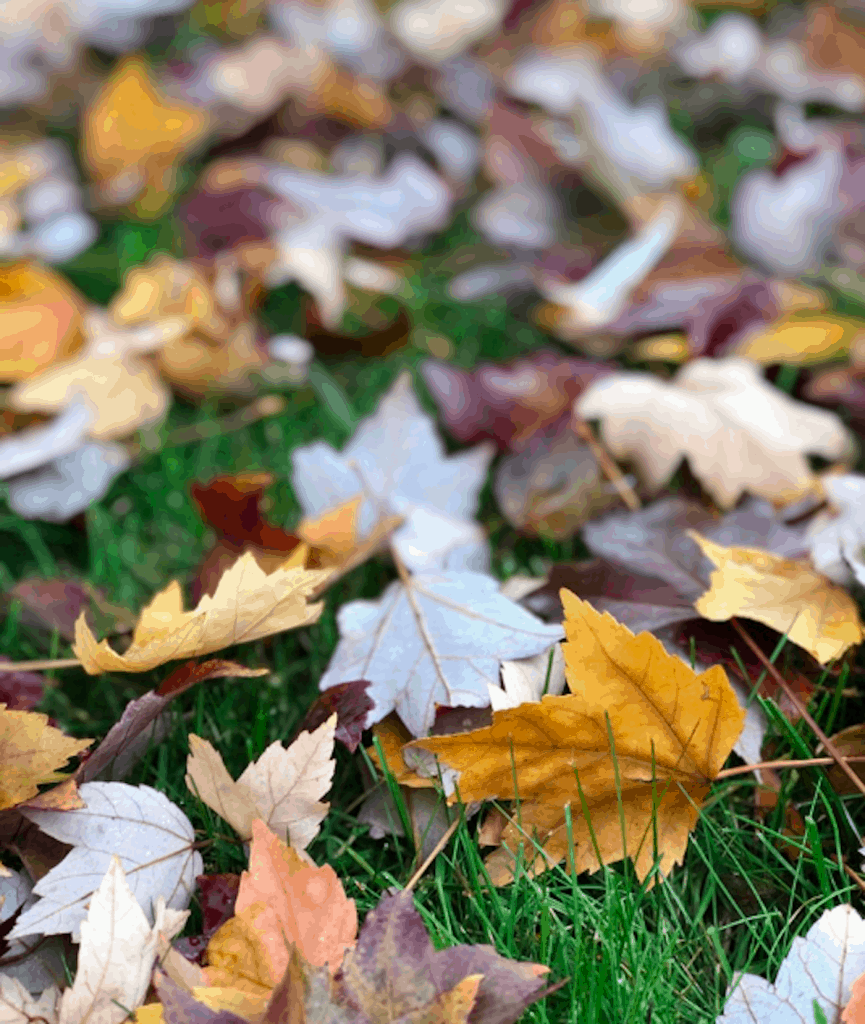 Autumn leaves and green grass clippings can be the perfect mix!
Autumn leaves and green grass clippings can be the perfect mix!
The Carbon to Nitrogen Ratio (C:N)
Now for some more details! A good carbon to nitrogen ratio for a home compost pile is about 30:1, meaning 30 pounds of carbon for each pound of nitrogen.
“You should have about 30 parts carbon to one part nitrogen by weight. This combination will help microorganisms do their job quickly.”
How Compost Happens, University of Maine
Microbes need nitrogen (mostly proteins) and carbon (mostly carbohydrates). In general, living things require more carbon atoms than nitrogen atoms. A deficiency in either nutrient will limit microbial activity. The right ratio will result in quicker composting that is also more likely to be hot enough to kill harmful pathogens.
It’s important to note that carbon-rich products are generally loose and light, like dry autumn leaves. Nitrogen-rich ingredients are generally moist and dense, like a bucket of kitchen food scraps. A cubic foot of leaves will be much lighter than a cubic foot of kitchen scraps.
“Potential composters start thinking and realize that they have a lot of green stuff, but where do they get all of this brown stuff?”
Adam Footer, Bokashi Composting
Make sure you’re following the 30:1 ratio by weight rather than by volume! If you followed the ratio by volume there would be WAY too much nitrogen and the pile could get very wet and slimy. It’s ok to “eyeball it” and guess when mixing carbon and nitrogen-rich materials. Just try to add quite a bit more “brown” stuff than “green” stuff.
The Carbon-Nitrogen Ratios (C:N) of Compost Ingredients
To make a balanced compost pile, it’s important to know the approximate carbon and nitrogen contents of your ingredients. While each and every batch of ingredients is different and will have a varying ratio, there are some general patterns. The tables below provide guideline estimates of C:N for common compost ingredients. Keep in mind that each batch of ingredients is unique, and these ratios are merely an estimate!
“Green” nitrogen-rich compost ingredients have a carbon to nitrogen ratio of less than about 30:1. These materials have a higher nitrogen content than a balanced compost pile. Green materials are moist, fresh, dense, and rich in nitrogen.
Table 1: Estimated Carbon to Nitrogen Ratios of “Green” Compost Ingredients
“Green” Nitrogen-Rich IngredientsCarbon to Nitrogen RatioVegetable Scraps12:1Mixed Food Waste15:1Poultry Manure15:1Lawn Grass Clippings18:1Seaweed18:1Coffee Grounds20:1Cow Manure20:1Fruit Scraps30:1Horse Manure30:1
Remember that these are only guidelines, and that each batch of an ingredient would have to be individually tested to calculate it’s true ratio!
“Brown” carbon-rich compost ingredients have a carbon to nitrogen ratio of more than about 30:1. These materials have a higher carbon content than a balanced compost pile. Brown materials are generally dry, loose, and rich in carbon.
Table 2: Estimated Carbon to Nitrogen Ratios of “Brown” Compost Ingredients
“Brown” Carbon-Rich IngredientsCarbon to Nitrogen RatioFresh Leaves40:1Dried Autumn Leaves60:1Peat Moss60:1Straw80:1Pine Needles80:1Paper170:1Shredded Newspaper400:1Woody Twigs & Sticks400:1Sawdust500:1Cardboard500:1Wood700:1
As with the previous table, these values are merely estimates.

How Long Does it Take to Make Compost
So how long does it take to make compost? Compost can be made in as little as a month and can take up to two years. The amount of time it takes to make compost depends on factors like the type of decomposition, the temperature of the pile, and the ingredients in the mix.
A pile of leaves left simply to decompose on their own will take about two years to produce useable compost. This type of compost is referred to as leaf mold. Even after two years, there are often visible leaves in the mix, particularly on the top of the pile. Pieces of woody debris left in this condition will take even longer than 2 years to decompose.
A well-managed outdoor aerobic compost pile will generally produce useable compost in 2-6 months, depending on the time of year. Some highly-managed composts may be ready in as little as a month if the conditions are closely monitored and adjusted (and the outdoor environment is conducive to decomposition).
Modern compost tumblers can also produce compost in a month or two without as much manual labor as a compost pile. One notable example is the top-of-the-line Envirocycle Composter. With a pair of two composters, you could realistically have a batch of finished compost ready each month (unless it’s super cold out).
Anaerobic indoor bokashi composting generally takes 30-45 days. One reason is that bokasi compost practitioners are generally good about cutting up food scraps into small pieces (which decompose faster). The microbes are added to the mix separately, which also speeds things up. Once food waste has been “digested” for a couple weeks in a sealed container, it is mixed with soil either in an outdoor trench or a bucket. The last few weeks of decay are spent open to the air.
Large-scale industrial composting is generally done either with large commercial digesters or in ploughed windrows. The commercial digesters are like giant bokashi composters. They look kind of like the giant tanks in a beer brewery, and take about 6 weeks to make compost. The ploughed windrow composting operations are like giant outdoor compost piles. Dozers plough through the compost in long lines to ensure the mix is exposed to adequate oxygen. Windrow composting can take 3-12 months.
The Fastest “Composting” Method
There is another method for recycling food waste – a Countertop Electric Food Waste Digester. This little gizmo, called a “Foodcycler” sits in your kitchen kind of like a bread maker did in the 90’s. The digester dries out and sterilizes mixed food waste in 3 hours, reducing the volume by 90%. The little dried flakes of food residue can go straight into the garden. Pretty nifty!
How to Know When Compost is Ready
Compost is ready when it is dark, crumbly, and uniform. There shouldn’t be any visible chunks of remaining organic ingredients. It also shouldn’t smell bad, and instead should have a pleasant earthy odour. The decomposition process should be complete, leaving a stable mass of compost that’s ready for the garden.
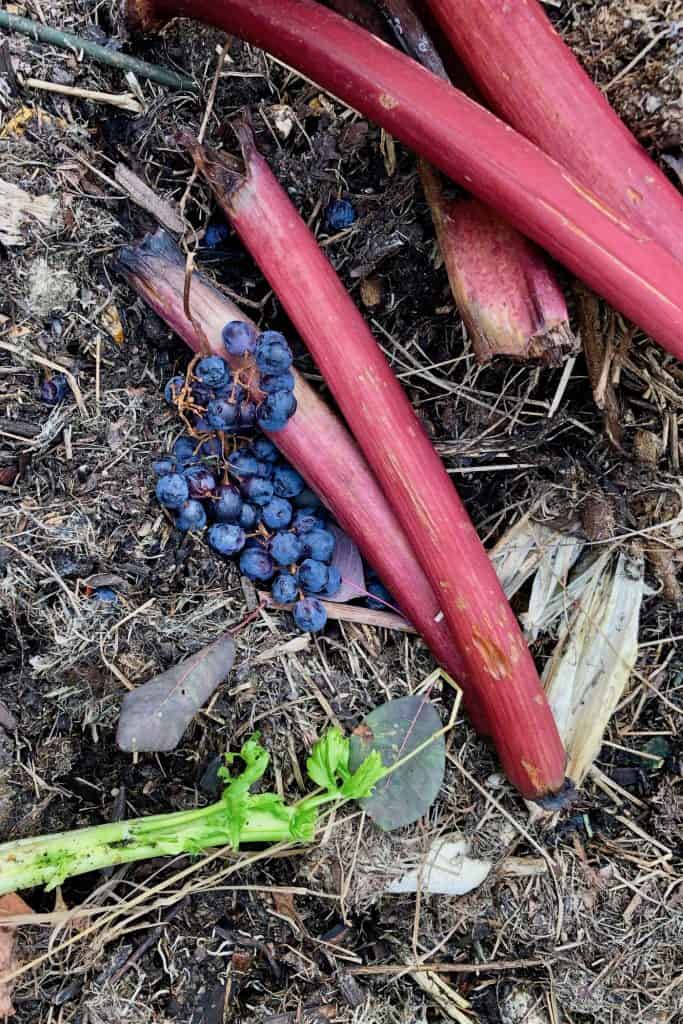
Compostable Materials: List of What to Put in the Compost
Here is a list of compostable materials to put in the compost:
Kitchen Scraps
Fruit and vegetable scraps can be composted in a tumbler, open bins, or simply a compost pile. Coffee grounds, washed eggshells, and tea bags can also go into the compost pile.
Meat, bones, fish, and cooked food require a more specialized composting environment. While these items will certainly decay in a regular pile, it makes sense to deal with them in a way that is less likely to attract pests.
If you would like to compost all your food waste, including meat, bones, fish, and cooked food, consider the following options:
- Countertop Electric Food Waste Digester
- Fancy Compost Tumbler (Envirocycle)
- Indoor Bokashi Fermentation Bin
- Green Cone Solar Waste Digester
- Commercial Pickup Service
Paper Products
Most paper products can be composted. Most paper can also be recycled, but it can also go into the compost. Certain fancy types of paper, like high-gloss paper, are best recycled instead of composted. Cardboard, newspaper, paper towel are also compostable. Shred paper products prior to putting them in the compost heap for best results.
Yard Waste
Yard waste is compostable, including leaves, grass clippings, twigs, and wood. Organic mulch from the garden such as straw is also perfect in a compost pile.
As with paper products, yard waste composts much faster if it is shredded into small pieces before composting. Large leaves can be shredded with a mulching lawnmower or a leaf vacuum. Wood is best composted in sawdust form. Larger pieces of wood can be cut up manually or with a rented shredder.
What Not to Put in the Compost
There are some items that definitely should not go in the compost. This includes non-degradable items, contaminated items, and sometimes even organic material that can be tricky to compost safely.
Obviously, inorganic materials like metal and plastic should be recycled rather than thrown in the compost heap. Every once and awhile I find a sticker from an apple in my garden and it reminds me that most plastic is NOT compostable! Take the time to separate out and recycle plastics and metals.
Contaminated items are also best kept out of compost. This includes chemically-treated wood, sawdust that is contaminated with chainsaw oil, pharmaceutical waste (including over-the-counter medicines), and petrochemical products. This waste must be disposed of properly in accordance with local regulations. These wastes are often incinerated by municipalities.
“Although almost all natural, organic material will compost, you shouldn’t put everything in your pile. Some wastes, such as fish scraps, bones, butter and meat, will attract pests and may smell. Other items, such as dog or cat manure, contain disease organisms that can survive the compost process and may attract other animals. Plants that are diseased or are infested with insects should not be added to your compost pile because they can cause future problems.”
How Compost Happens, University of Maine
There are some organic materials that CAN go into the compost in certain specialized conditions, but shouldn’t be tossed into your average backyard compost pile. Here are some examples of organic material that is technically compostable but does have certain requirements:
- Meat, bones, or fish
- Dairy products
- Grease, lard, or oil
- Whole eggs, mayonnaise, or salad dressing
- Food waste with pesticide residue
- Perennial weeds (especially with seeds)
- Annual weeds with seeds
- Diseased plants
- Leaves from black walnut trees
- Livestock manure
- Pet waste*
*Composting Pet Waste
Composting pet waste deserves an extra mention. Many pet owners wonder what is the best ways to dispose of pet waste. Should it go down the toilet? Can it be composted? Is it destined for the landfill as untreated sewage?
Do not add pet or human wastes to a compost pile.
Compost and Composting Resources, University of Arkansas
Pet waste is compostable, but it should only be composted in a specialized composter. Pet waste should not go into an open compost pile or a standard tumbler. Compost that contains pet waste should not be used on or near gardens growing edible plants.
As of writing, The Green Cone Solar Waste Digester is the only home composter I know of that advertises it can compost “light pet waste”.
Some Envirocycle users mention in their online reviews that they compost pet waste in their Envirocycle compost tumblers. On the specifications sheet for the product, however, the manufacturer recommends against this and notes: “Animal or human waste may contain harmful microorganisms, including pathogens or parasites, that can be harmful or fatal to humans. If you chose to use animal or human waste in an Envirocycle Composter, it is at your own risk.”
Here is a helpful article from Zero Waste Pet about sustainable ways to dispose of pet waste (and why you shouldn’t flush it!).
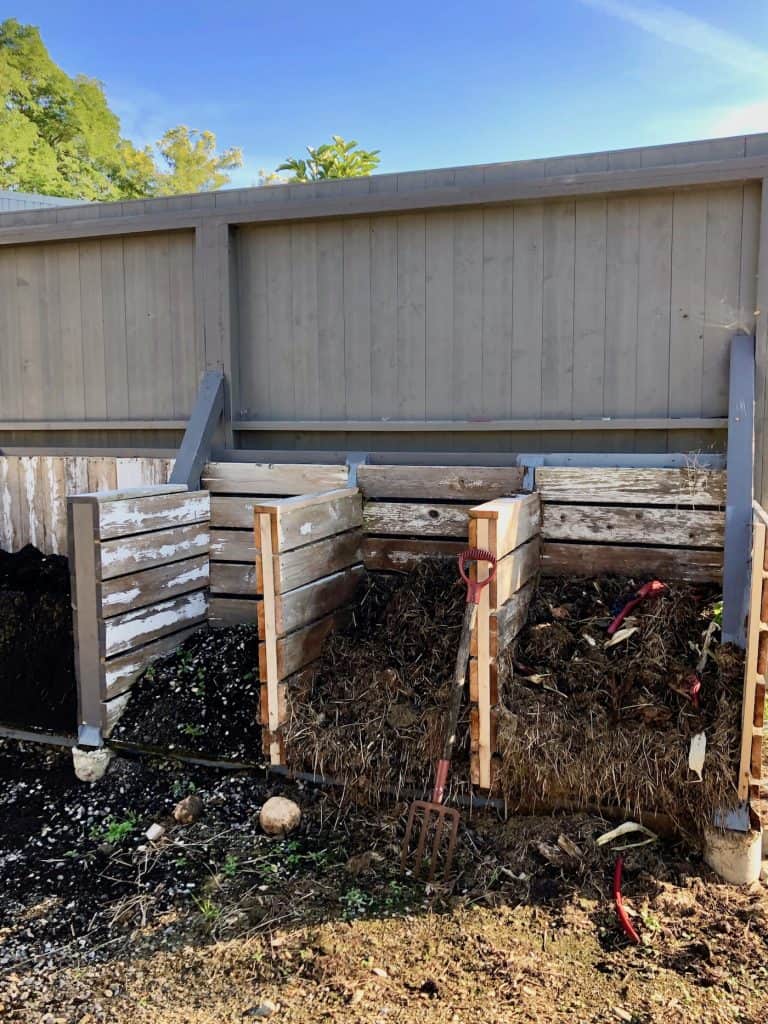
Composting Methods
Let’s learn all about different composting methods! Many households like to combine a couple different methods after they get a handle on basic composting. Here is a list of some common composting methods.
Backyard Composting Methods
- Compost Pile
- Compost Bins
- In-Place Composting
- Green Cone Solar Waste Digester
Urban Composting Methods
- Compost Tumbler
- Countertop Electric Food Waste Digester
- Bokashi Indoor Food Waste Fermenter
- Vermicompost (Indoor Worm Composting)
- Curbside Organics Collection
Industrial Composting Methods
- Large-Scale Organic Waste Digesting
- Municipal Waste Windrow Composting
- Agricultural Waste Windrow Composting
Let’s look at each of these three composting categories, starting with plain old composting and ending with large-scale industrial food waste processing.
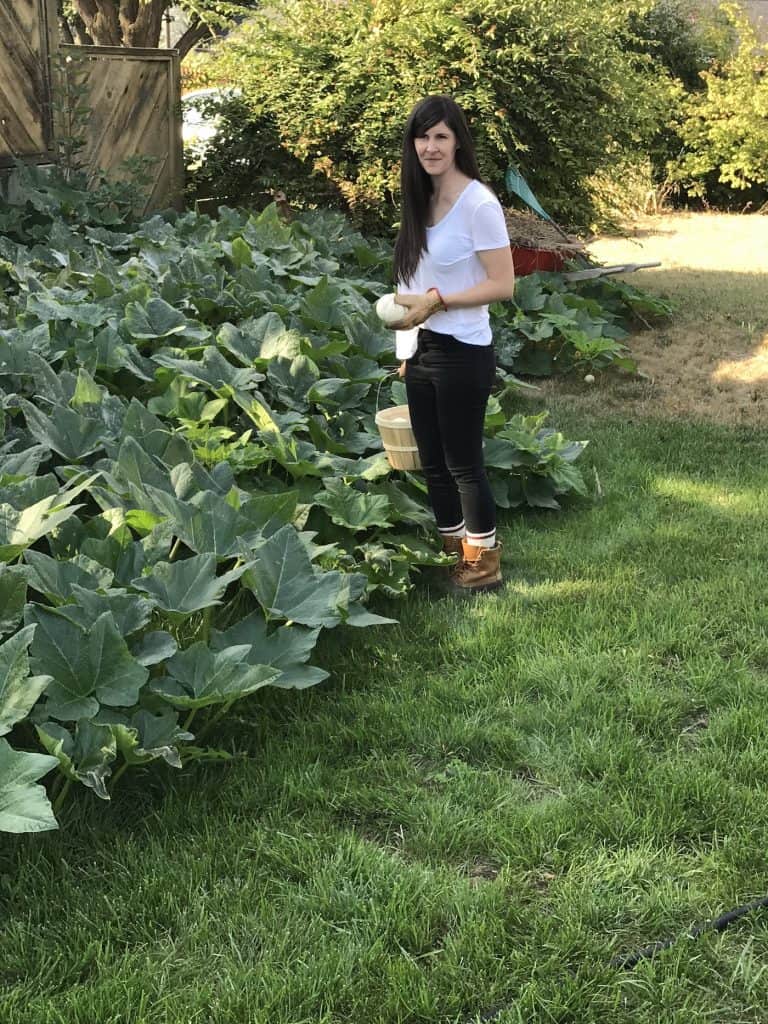 Who else has ever had pumpkins growing out of an unattended compost pile!?
Who else has ever had pumpkins growing out of an unattended compost pile!?
Types of Backyard Composting
Backyard composting is a wonderful family-friendly activity for those with lawns and gardens. It doesn’t have to be messy – there are lots of options for backyard composting!
Whatever method you choose, the backyard compost should be located in a level, well-drained area. In cool climates, putting it in a sunny spot can help trap solar heat. Shade in warmer climates may keep the compost from drying out.
Compost Piles
A backyard compost pile is the quintessential home composting method. In it’s simplest form, a compost pile is just a heap of organic matter sitting around and waiting to decompose.
Compost materials should be added to the pile in the following order:
– 6 inch layer of brown material
– 2 inch layer of green material
– 2 inch layer of soil, which contain decomposers and help prevent odors from developing.
Home Composting: A Guide for Home Gardeners, Pennsylvania State University
The pile should be at least a yard wide/deep/tall. The pit can be on a patch of level ground, dug into a shallow pit, or placed on top of a hard outdoor surface.
“Composting is best done in shallow (two feet) pits or on concrete slabs, but any nearly level piece of ground will do.”
Harold Willis, Foundations of Natural Farming
For aerobic composting, arrange the pile so lots of surface area is exposed. Turn a compost pile several times during the first eight weeks of composting. The more often the compost pile is turned, the quicker it will decompose.
Compost Bins
The next step up in composting complexity is a compost bin. Compost bins can be purchased or made from chicken wire. They can be made from old pallets or from stakes with hardware cloth. Check out Pinterest for some great ideas like these for DIY compost bins!
- bin made of hay bales
- salvaged shipping pallet compost bin
- wooden 3-bin structure
- mesh compost bin of chicken wire with metal posts
A popular compost bin setup is the 3-Bin Compost system. In this layout, there are three compost bins side by side. Each bin is about one cubic yard. The successive bins allow the user to “turn” the compost from one bin into the next. You can have a batch of compost that’s actively added to, one that’s on it’s way to decay, and another bin of finished compost for use in the garden.
Home and garden centres also sell pre-made compost bins. Some are simply an open cube, while others are stacked systems. The stacked bins are more expensive but come with extra features. If you have only a small backyard, a manufactured stacked bin might be a better choice than a large 3-bin system.
In-Place Composting
Backyard composting also allows for in-place composting. Some gardeners compost their organics directly in a trench in the ground. Others practice “lasagna composting” and or “sheet composting” lay down layers of organics.
Backyard Organic Waste Digesters
Lastly, there are backyard digesters. As discussed before, the Green Cone Solar Digester is a good option for those more concerned with dealing with waste than those who want to make plant food. Consider your reasons for composting before choosing a method!

Types of Urban Composting
Urban composting becomes more and more popular each year as the focus on sustainability increases in our culture. These methods of composting are good for those in apartments, those with winter, those who just don’t like to walk outside to the compost pile!
Here are the details about some common types of composters for city dwellers, including those in apartments, those with small balconies or patios, and those with access to an outdoor lawn or rooftop.
Urban Compost Tumblers
Compost Tumblers are a great choice for urban composting if you’ve got a little bit of access to an outdoor space. A basic two-compartment compost tumbler provides enough space for a family’s food waste without taking up too much valuable outdoor square footage.
One compost tumbler that is totally beloved by urbanites and rural folk alike is the Envirocycle compost tumbler. You can pop a pair of these guys on the patio and get started composting right away! They are the least ugly to look at and you can get them in mini size (and even in pink). They’re not cheap but are certainly made to last.
Countertop Electric Food Waste Digester
The “Foodcycle” countertop electric food waste digester is a little energy-efficient gadget that dries out and sterilizes food waste. It only takes 3 hours to complete a batch, and the little bucket is dishwasher safe. The food waste volume shrinks by 90% and the remaining dried food particles can be sprinkled directly on the soil. Again, this is not cheap, but it’s perfect for those with no outdoor space of their own!
Bokashi Indoor Food Waste Fermenter
A bokashi indoor food waste fermenter is a sealed unit about the size of a five-gallon bucket. It uses an aenerobic process to decompose food waste in about a month. This is a stinky process, but theoretically, the smell *should* be contained to the sealed unit.
The bokashi composting method uses specific microbes to ferment organic matter. Bokashi composting doesn’t require mixing “greens” and “browns”, it doesn’t need to be turned, and it doesn’t require oxygen or aeration. Bokashi composting requires less work than traditional aerobic composting.
“The roots of bokashi composting lie in Japan and Southeast Asia, where it is widely practiced.”
Adam Footer, Bokashi Composting
Bokashi is a closed-system type of composting. Because the system is closed, all types of food waste can go into bokashi compost, including meat, dairy, and bread. Because its airtight, odors shouldn’t escape and insects and rodents can’t get in.
“Even though the fermentation process suppresses putrefaction and the rancid doors that accompany it, the process does produce a typically vinegar, pickle smell that is closer to pleasant than putrid. But again, the container is sealed shut so you can ferment your food waste inside your home or apartment and even the most sensitive noses won’t be able to detect an odor.”
Adam Footer, Bokashi Composting
Even though all food waste can be digested in an indoor bokashi fermenter, it does best if diced into small pieces. The bokashi process includes purchasing and adding a microbe-inoculated “bran”. Bokashi bran or bokashi powder is a carbon base material that is inoculated with a specific set of beneficial organisms.
Properly managed bokashi compost is a good option for apartments, offices, or those with a small yard. The bucket is sealed. Inside the bucket will be very smelly while it ferments, but the bucket should stay sealed while it’s really smelly.
“You can compost whatever you have, and what most people have are a lot of food scraps. These are ideally suited to be composted using bokashi.”
Adam Footer, Bokashi Composting
Bokashi is generally done with food waste. Some gardeners create a bokashi-like mix with their yard waste in the fall by filling up a plastic garbage bag with mixed shredded waste. Put some water in the bag and bit of finished compost, tie the bag tight, and put it in the sun.
Vermicompost (Indoor Worm Composting)
Vermicompost, or indoor worm composting, is like a mini stacked compost bin that goes indoors. While DIY worm bins are common, new worm bin users generally prefer to buy a vermicomposting kit to get started. You buy some worms, their little stacked plastic house, and get going! It sounds a little creepy to have worms living inside your home…but hey…some people love it!
Curbside Organics Collection
Curbside organics collection is a wonderful option for urban composting. All you have to do is collect the material and put it out for collection! It doesn’t get much easier. Compost can be kept in a dedicated bin under the sink or even in a compostable bag in the freezer. Some cities have municipal organic waste collection programs, while other areas are serviced by private composting companies who collect waste weekly.
Industrial Composting Methods
Industrial composting methods emulate home composting, just on a much larger scale! Sealed organic waste digesters are a lot like giant bokashi buckets. Long windrows ploughed by bulldozers are a giant version of turning over a compost pile from one bin to the next. While users miss the satisfaction of home composting, there are certainly efficiencies to composting on a large-scale that are worth considering.
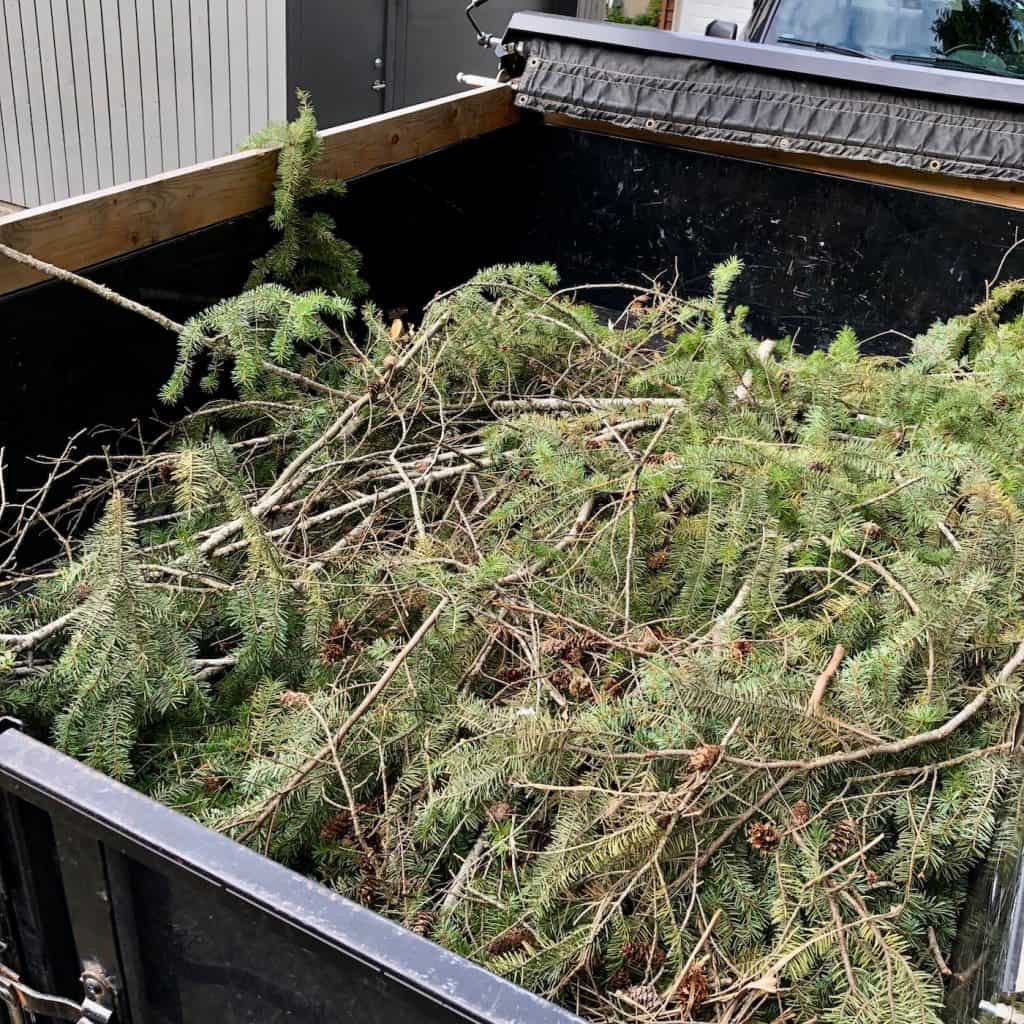
Troubleshooting Compost Problems
Here are some common problems with composting and solutions for how to address these issues. If your issue isn’t listed below, also check out the troubleshooting section of this helpful guide from the University of Maine.
Smelly Compost
Wet, slimy, smelly compost is generally caused by adding too much nitrogen-rich “green” material. Address such a pile by turning in dry, carbon-rich “brown” substances like autumn leaves, sawdust, or shredded newspaper. It can also help to ensure the pile can drain water freely.
“For an aerobic composting process to work optimally and quickly, you need to get the carbon-to-nitrogen ratio right, approximately 30:1. Most people don’t get the ratio right, and that is why a lot of traditional compost piles fail”
Adam Footer, Bokashi Composting
Matted Material in Compost
Slimy wet mats of leaves, grass clippings, and sawdust can also form when the pieces added to the compost are simply too big. Leaves should be shredded prior to composting for the best results. Sprinkle thin layers of grass clippings and sawdust rather than placing it in piles.
If mats have appeared, remove them and break them apart manually. Add them back in gradually, bit by bit.
Pest Animals Getting Into the Compost
Pest animals getting into compost are absolutely no fun! Whether its racoons, rats, mice, or just flies, there are certainly unwanted pests who just love our compost bins.
The first step is to keep a well-maintained compost with a proper carbon-to-nitrogen ratio. It can be tricky to find enough carbon to balance out kitchen scraps, but it is worth it to cover up the “green” material and make your pile less enticing. Maybe your neighbours have some extra leaves!
“If you regularly make a compost or leaf mold pile, you may well have an opossum or other animals sleeping in it for at least part of the year. If you don’t want to encourage these creatures, make sure wire bins don’t have any gaps, or use solid-sided bins.”
Rodale’s Illustrated Encyclopedia of Organic Gardening: The Complete Guide to Natural & Chemical-Free Gardening
The next step is to remove food waste from the pile altogether. Just compost leaves, twigs, and other unappealing items. Add a bit of nitrogen-rich organic fertilizer or some coffee grounds to balance out the C:N ratio.
In spring, when it was time to dig compost out, we would always shudder, knowing we would find a rats’ nest embedded in the warm compost pile. When we moved to the country, we made the decision to eliminate kitchen scraps from the compost altogether to see if it would eliminate the rat problem – and it worked!
Carolyn Herriot, The Zero-Mile Diet
There are numerous alternative composting methods above that are better suited to processing kitchen scraps than an open compost pile. Consider having a large outdoor compost for yard waste while keeping the food waste that attracts pests in a smaller, contained system.

Ideas for Improving Home Compost
Like anything in the garden, there is always room for compost to improve! Here are some ideas for improving home compost if you’ve got the basics down.
Compost Activators
Compost activators are products that boost the biological activity of your compost. The most basic “compost activator” is simply a shovel-ful of existing compost. There are products labelled as “compost starter” or “innoculant” that can certainly give your compost a boost if you think it needs it.
“Adding about 10-20% soil will help supply soil microorganisms to the pile, help absorb ammonia (conserve nitrogen), buffer pH and speed composting (sand and heavy clays are not good).”
Harold Willis, Foundations of Natural Farming
Shred ‘Em
Make double-sure you are shredding up your compost ingredients! Big autumn leaves and mats of newspaper will not compost as efficiently as neatly shredded items will. A little time spent on increasing the surface area of your ingredients will certainly improve your compost.
Turn the Compost Often
Aerobic compost like a compost pile, bin, or tumbler should be turned often to decompose efficiently. Think of it as a free gym pass! Try to turn the compost once a week. I suppose you could turn it a few times a week, but I have never had the time or inclination to test that out.
Keep it Moist
A compost pile may have to be watered in dry spells or during the summer. It can also get too damp in rainy spells. The pile should be moist but not wet. Compost piles in the sun will almost certainly need some added water in the heat of summer. Water the pile layer-by-layer as it is turned over.
Add Earthworms
Find some lovely worms to add to your compost heap! Worms will help decompose the organic matter. If your pile isn’t already highly-populated, dig up some worms to add to the mix.
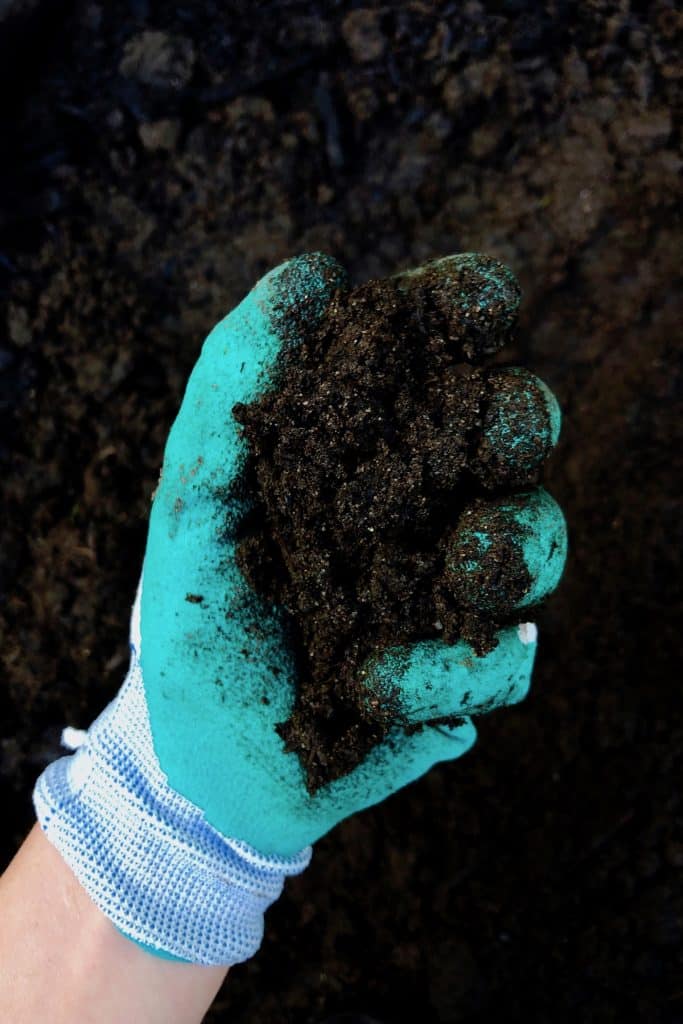
How to Use Compost in the Garden
final product that helps plants retain water and nutrients, and improves drainage and soil structure. Plus, turning yard and food waste into compost can greatly reduce your landfill contribution.
“A healthy plant is surrounded by microbes all the way from roots to flowers.”
Brett L. Markham, The MiniFarming Guide to Composting
Backyard composting isn’t as complicated or messy as you might think. By combining a few simple ingredients in the right proportions, you can be on your way to reducing food waste and creating a soil conditioner that benefits both your garden and the planet. Learn more about what compost is and how to start composting at home.
What to Do with Finished Compost
- Feed Houseplants
- Mulch Outdoor Gardens
- Top-Dress the Lawn
- Give to Neighbours
- Donate to Local Garden Club
- Gift to the Local Community Garden.
